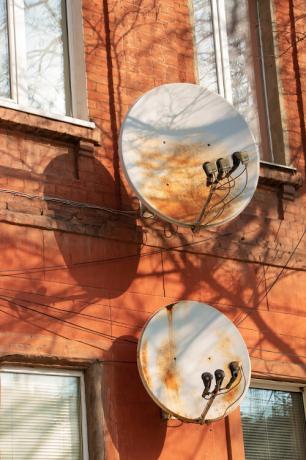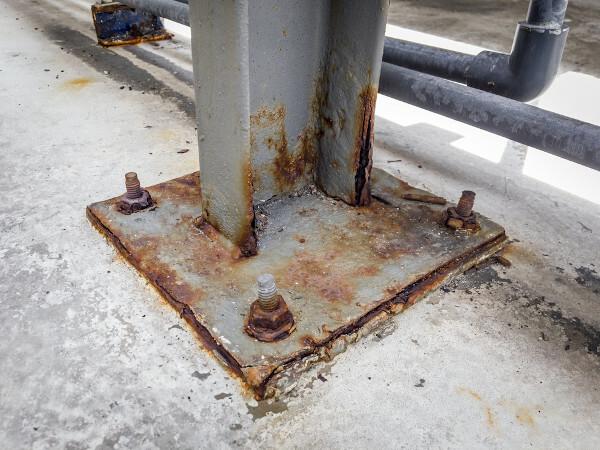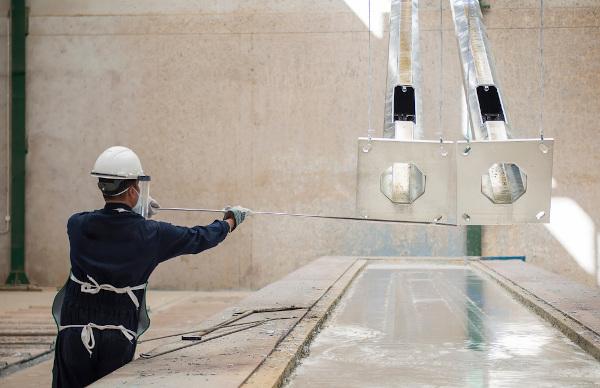Rust It is a reddish-brown stain that appears on iron or ferrous surfaces when they are exposed to air and moisture. As metallic iron is unstable in contact with air, it forms by the oxidation of metallic iron to iron oxides or hydroxides, commonly represented by the chemical formula FeOOH.
Rust is a major problem for society as it significantly damages structures such as bridges, buildings, vehicles, engines, among others, requiring large expenses with repair and maintenance. Rust is a type of corrosion, a spontaneous phenomenon of the destruction of metals and alloys. Currently, several techniques, such as galvanization, are used to reduce the impacts of rust formation.
Read too: How is salt air related to the corrosion of metals?
rust summary
Rust is characterized by reddish-brown stains that form on iron surfaces and ferrous alloys that are in contact with air and moisture.
Rust forms when iron, which is unstable in the presence of atmospheric oxygen, is oxidized to iron oxides and hydroxides.
It can be represented by the general chemical formula FeOOH.
The main component of rust is hydrated iron III oxide, Fe2O3∙H2O.
Rust is a major problem for countries and companies, as maintenance and repair costs are high.
It causes major structural impacts, as it mechanically weakens metallic structures.
There are techniques to decrease or mitigate rust, such as cathodic protection and galvanization.
Rust formation is a type of corrosion.
What causes rust?
Rust is a reddish-brown stain that appears on metallic surfaces, more specifically on iron and ferrous alloys, when they are exposed to the atmosphere or submerged in natural waters. In that case, metallic iron (Fe) is oxidized to a mixture of oxides (Fe2O3∙H2O and Fe3O4) and hydroxides (Fe(OH)2, Fe(OH)3) of iron, which are also commonly represented by the FeOOH formula, which seeks to condense all the iron phases present in rust.
The process that causes rust is chemically known as corrosion., consequence of the action of the environment on a material, leading to its deterioration, starting from its surface.
How does rust occur?
Metallic iron is thermodynamically unstable in the presence of oxygen gas., which constitutes about 20% of our atmosphere and is the medium in which such metal is most frequently exposed.
Under these conditions, its oxide forms FeO (iron oxide II), Fe2O3 (Iron III oxide) and Fe3O4 (Iron II, III oxide). The presence of water makes the medium even more aggressive, favoring the formation of rust (FeOOH). Just as basic salts and hydroxides need water for their formation, rust, a mixture of oxides and hydroxides, also needs water, making the role of relative humidity clear:
4 Fe3O4 (s) + O2 (g) + 6H2O (l) → 12 FeOOH (s)
In regions of high relative humidity of the air, the formation of the so-called corrosion pile is common., due to the formation of a sheet of water that condenses (liquefies) on the metal surface in whole or in part.

In this case, we must pay attention to the standard reduction potentials of the species involved:
Faith2+ (aq)/Fe (s): E° = –0.44 V
Faith3+ (here)/Fe2+ (aq): E° = 0.77 V
O2 (g)/OH– (aq): E° = 0.82 V
The values show that The process in which Fe is oxidized by O is chemically spontaneous.2 dissolved in water, since iron has a lower standard reduction potential. Therefore, we have to:
Fe(s) → Fe2+ (aq) + 2 and–
O2 (g) + 2H2O(l) + 4 and– → 4OH– (here)
In brief, Rust formation can be given as:
2 Fe2+ (aq) + O2 (g) + 4 OH– (aq) → 2 FeOOH (s) + 2 H2O(l)
Although the concentration of oxygen in air is constant, its solubility in water is low (1.4 x 10–3 mol. L–1 H2O at 20 °C), which is rapidly consumed on the steel surface (metal alloy composed mainly of iron and carbon). Although constantly replenished by the air, this oxygen, at every instant, must pass through a layer thicker layer of rust to strike the steel again, which slows down the speed of rust over time. corrosion.
types of rust

Rust will vary in color depending on the amount of oxygen and moisture.
Red rust: rich in Fe2O3∙H2O (hydrated iron III oxide), occurs in environments of high oxygenation and humidity, being the most common form, forming uniformly.
Yellow rust: rich in FeO(OH)H2O (or Fe(OH)3), occurs in high humidity environments, usually in metals found with large amounts of standing water, such as near sinks and bathtubs.
black rust: rich in Fe3O4, occurs in environments of low oxygen concentration and moderate humidity. It appears as black spots, not being produced quickly, and therefore it is easy to combat.
brown rust: rich in Fe2O3, occurs in environments with a high concentration of oxygen and low humidity (even without). Because of this, it is a much drier type of rust, not occurring uniformly, but in specific points on the surface.
See too: What are the types of corrosion?
Chemical composition of rust
Commonly, it is said that rust is composed of hydrated iron III oxide (Fe2O3∙H2O), but it can be understood that other species of iron are present in its composition. like iron it's a metal little stable in contact with oxygen in the air, it is normal for parts of this metal to form a thin layer of Fe3O4 (magnetite) on its surface. The constant contact with oxygen in the air and humidity gives rise to other oxidized species, such as FeOOH, in the crystalline forms α-FeOOH (goethite) and γ-FeOOH (lepidocrocite). These species overlap in layers along the rust.
consequences of rust
The process of rust formation is within the field of corrosion., a problem of great impact on the economies of industrialized and developed countries.
It is estimated that around 30% of the world's iron and steel production is lost to corrosion., a cost that can correspond to 1 to 5% of the GDP of the countries. In 2019, for example, Brazil spent around BRL 290 billion (about 4% of its GDP) on corrosion maintenance.
The costs of maintaining structures are necessary, since replacement can be more expensive, and, in addition, rust causes serious damage to structural safety. When oxidizing, the metal loses its good mechanical properties. The oxides formed, in general, are brittle and can compromise parts, structures and equipment. Not only that, they can also contaminate the packaged product, if this, for example, is food.

In addition to the direct costs of replacing and maintaining rusted parts, rust can also bring indirect problems. A structure such as a bridge or an overpass, which needs to be closed for maintenance, can cause major disruptions in the movement of people, affecting communities and the work routine. Rusty machinery can lose efficiency or be removed from the production line for maintenance, thus decreasing productivity.
How to avoid rust?
Currently there are already antioxidative or anticorrosive techniques that drastically reduce the formation of rust on metal parts. Among them, we can highlight some, such as cathodic and anodic protection, anti-corrosion coatings and corrosion inhibitors.

In cathodic protection, the metal of interest is protected by a metal of easier oxidation (lower reduction potential) inserted in its structure, which gives rise to a galvanic cell. In this way, the inserted metal acts as an anode, oxidizes, and then protects the metallic structure of interest, which acts as a cathode and remains in its reduced (metallic) form. The inserted anode is commonly known, in this technique, as “sacrificial metal”, precisely because it oxidizes in place of another.
The use of coatings prevents the metal structure from coming into contact with the oxidative environment, thus creating a barrier that will hinder or even prevent the formation of rust. An example is the epoxide paints and red lead, which protect pipes, railings, gates, among other items. Another known coating is galvanization, which consists of coating the iron piece with a less noble metal. This is the case of galvanized screws, in which the iron structure is coated with zinc metal.

Corrosion inhibitors are chemical substances, of an organic or inorganic nature, which are added to the environment in order to prevent the process of rust formation. The idea is to generate products in the medium that form protective films and act as a barrier to the metal, making contact with the oxidizing medium difficult. To learn more about ways to prevent rust, click here.
What is the difference between rust and corrosion?
Rust is actually the substance formed during the corrosion process of iron and its alloys, such as steel. Corrosion is broader, as it concerns all processes of spontaneous destruction of metals and alloys, caused by chemical, biochemical and electrochemical interactions between metals and alloys with the environment environment. During corrosion, metals are converted into thermodynamically more stable compounds such as oxides, hydroxides, salts or carbonates. Therefore, we can say that the formation of rust is one of the processes of corrosion.
Some authors say that rust is a consequence of the process of wet corrosion or corrosion electrochemistry, since such a process needs the presence of water to occur and it happens spontaneously.
Sources
AZ RUST. What is Rust & The Most Common Types of Rust. AZ Rust, c2023. Available in: https://azrust.com/what-is-rust/.
CARNEIRO, C. Spending to contain steel corrosion impacts 4% of Brazilian GDP. SEGS, 2022. Available in: https://www.segs.com.br/mais/economia/338194-gastos-para-conter-corrosao-do-aco-impactam-4-do-pib-brasileiro.
CURTISS-WRIGHT SURFACE TECHNOLOGIES. Types of rusting and how metal surface treatment can help prevent oxidation. Curtiss-Wright Surface Technologies, 2020. Available in: https://www.cwst.co.uk/types-of-rusting-and-how-metal-surface-treatment-can-help-prevent-oxidation/.
MERCIER, J. P.; ZAMBELLI, G.; KURZ, W. Corrosion, degradation and aging. In: Introduction to Materials Science, P. 379-399, 2002.
MERÇON, F.; GUIMARÃES, P. i. W.; MAINIER, F. B. Corrosion: A Usual Example of a Chemical Phenomenon. New Chemistry at School. n. 19, 2004. Available in: http://qnesc.sbq.org.br/online/qnesc19/a04.pdf.
POPOV, b. No. Corrosion Engineering: Principles and Solved Problems. Oxford: Elsevier, 2015.
SILVA, m. v. F.; PEREIRA, M. W.; CODARO, E. N.; ACCIARI, H. A. Corrosion of carbon steel: an everyday approach in chemistry teaching. New Chemistry, v. 38, no. 2, p. 293-296, 2015. Available in: https://s3.sa-east-1.amazonaws.com/static.sites.sbq.org.br/quimicanova.sbq.org.br/pdf/v38n2a22.pdf.
By Stefano Araujo Novais
Chemistry teacher

